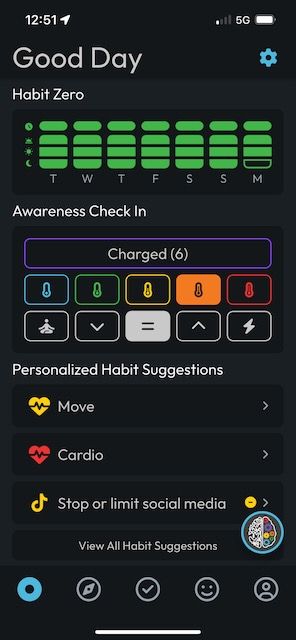
My Secret Weapon - Meditation 101
“Suppose you read about a pill that you could take once a day to reduce anxiety and increase your contentment. Would you take it? Suppose further that the pill has a great variety of side effects, all of them good: increased self-esteem, empathy, and trust; it even improves memory. Suppose, finally, that the pill is all natural and costs nothing. Now would you take it? The pill exists. It’s called meditation.” - from The Happiness Hypothesis - Jonathan Haidt
We should all have a secret weapon. My secret weapon helps me to reduce stress and anxiety. It helps to shorten my recovery time from emotional hijacks, helps to keep me calm under pressure and improves my ability to bounce back after setbacks. It helps to increase my self-confidence, self-awareness, my overall level of happiness and personal satisfaction. It also improves my ability to influence, enhances my productivity, and heightens my level of awareness.
What is my secret weapon?
It’s called meditation. This month I’ve hit a significant milestone. As of this writing, I’m on a one-thousand-and-three-day meditation streak. I’ve meditated, every single day, for the past 2,847 days. And I plan to continue this streak every single day, for the rest of my life. Why would I put so much effort and commitment toward a single activity? Because I believe it is the single most important activity that I can do to improve my level of performance, reduce stress/anxiety and increase my level of happiness and overall personal satisfaction. Here are three benefits that I get out of meditation:
It’s exercise for my mind.
Your mind requires exercise just like your body needs exercise. When you meditate, the muscles that you are exercising are the muscles of your conscious awareness. These are intention and attention. When you practice meditation, you are training your intention - your ability to make good choices and follow through on them - and your attention - your ability to concentrate and focus and develop heightened levels of sensory-acuity.
It’s the foundation of mindful leadership.
I believe that mindfulness is the missing ingredient that separates terrible leaders from the exceptional. All leadership experts agree that self-awareness is the key to unlocking your leadership potential. When you train for any sport, you go to practice. When you practice, you perform drills or repetitive tasks that build up muscle memory. So, when game day comes around, you perform your best. Meditation is the practice (repetitive drills) of mindfulness. Meditation is what you do on the mat. Mindfulness is what you do off the mat. I wouldn’t be able to call myself a mindful leader if I didn’t walk my talk.
It’s backed by science.
There’s tons of scientific evidence that shows the benefits of meditation. One study found that it’s better than antidepressants for depression and anxiety and another study shows that it improves concentration and attention. I used to suffer from panic attacks, but since I established my daily meditation routine, they have all but disappeared.
Meditation 101
I’ve had a few people inquire about my meditation practice, so I put together this list of tips and tricks to help you get started.
1) It doesn’t matter how you sit as long as you are sitting comfortably.
We’ve all seen pictures of people meditating, with their legs crossed in a lotus position, with their hands on their knees, palms up, with thumb and middle finger touching. I don’t meditate in this position; I find it way too uncomfortable. Within 5 min my feet fall asleep (pins and needles), and my legs begin to cramp up. You can get the benefits of meditation, regardless of how you sit. Make sure you are sitting comfortably and follow these simple guidelines:
- Sit with a tall and relaxed back.
- Relax your shoulders and hold your head up.
- Put your hands on your thighs or cupped together in your lap.
- Legs can be crossed or feet on the ground.
- Relax the muscles around the eyes and put a slight smile on your face.
- Close your eyes or keep them lowered to a point on the floor in front of you (free of any distractions).
2) Start with a couple of deep breaths.
I like to take a moment to pause and slow down before starting a meditation session. To transition (from whatever I happen to be doing) into a meditative state I find it useful to start with a couple of deep breaths in, and long breaths out. I like to use a 4-4-8 count. Take a deep breath in on the count of 4, hold to a count of 4, and then breathe out to a count of 8. Do about 3 or 4 of these and then allow your breathing to return to normal.
3) Meditation is exercise for your mind.
When you practice meditation, you are training the muscles of your mind, intention and attention. To exercise your intention: When you start your meditation, direct your mind by setting an intention to be still and to relax for a fixed period. To exercise your attention: Throughout your meditation, you direct your attention to any number of areas. Options include your breathing, a body scan or perhaps a mantra.
4) Focus on the breath.
When I meditate, I like to focus on my breathing. You want to draw your attention to where you notice your breath the most. When you take a breath through your nose, do you notice it in the rise and fall of your chest? Or perhaps you notice the air flowing in and out of your nasal cavity. Or do you notice the fresh air flowing over your upper lip when you breathe in and the warm air when you breathe out? The great thing about focusing on your breath is that it makes meditation very easy, regardless of where you are. Because you always have your breath with you.
5) You will get distracted by the monkey mind.
“The goal of meditation isn't to control your thoughts; it's to stop letting them control you.” - Jon Andre
You will probably notice that your mind is very, very busy. After just a few breaths you will start thinking about something at work. Or you will notice an ache in your big toe. Or perhaps about a conversation with your kids. Or perhaps something you need to add to your to-do list. Or perhaps … you get the idea. Don’t worry, this is normal. There is a never-ending stream of thoughts moving into your conscious awareness (flowing from your unconscious mind). What do you do when you notice you’ve been caught up in a thought? You come back and return your focus to your breathing. Repeat this process again and again, for the duration of your meditation session. Going back to the exercise metaphor, the noticing and shifting back to your breath is like doing an arm curl when you exercise. The secret to sticking with your meditation practice is to say “Amazing, another opportunity to train my brain!” every time you get distracted.
6) Go easy on yourself.
You do not what to be too hard on yourself during your meditation. It’s crucial that you be supportive and understanding to yourself. Most of us are way too hard on ourselves and the language we use to talk to ourselves; we would never say to another person. Another intention of meditation is to practice being kinder to ourselves by being non-judgemental. When you notice that you been caught up in a thought, just return your attention back to your breath without judgement. Don’t beat yourself up about it, practice being kind to yourself. Just return your attention to your breath, without judgement.
7) Some sessions will be amazing, and others will be a struggle.
After meditating daily for a couple of weeks, I remember having some really deep and calming sessions. I was able to keep my attention on my breath for almost the entire session. After having these amazing sessions, I found it frustrating when I started to get distracted. At one point my sessions were getting worse. I was unable to stay focused on my breath for more than a few seconds. This is normal! Some sessions will be amazing, and other will be a struggle. Once again, avoid beating yourself up for this. View each session on its own, doing the best you can at the moment, and avoid comparing your current session with past sessions.
8) Start with 10 min.
When you first start, I recommend that you meditate for 10 min. Ten minutes is not very long and as you progress you can add more time. I’m currently up to 25 min, and I find this to be the sweet spot for me. Set a countdown timer with a quiet alarm, so it doesn’t jar you out of your meditation. A simple bing or gong sound at the end of your session works best.
9) Meditate at the same time every day.
As with any new habit or ritual, one of the best ways to improve your chances of sticking with it, is to perform the ritual at the same time every day. For me, this is first thing in the morning, right after I wake up. I wake up at 5 am (without an alarm), and the first thing I do is meditate for 25 min. This has been my morning ritual for almost three years.
10) Don’t break the chain.
When Jerry Seinfeld was an up-and-coming comic, he knew that to become a better comic was to create better jokes and the way to create better jokes was to write one every day.
"After a few days, you'll have a chain. Just keep at it, and the chain will grow longer every day. You'll like seeing that chain, especially when you get a few weeks under your belt. Your only job next is not to break the chain." - Jerry Seinfeld
This same advice can be applied to any new habit, including meditation. This is how I secret behind how I achieved my current 1,003-day meditation streak. I’ve made the commitment to myself that I with NEVER break the chain.
11) There’s an #app4that.
I’ve tried many meditation apps, and my favourite is Calm. Calm is free to download, and they have a great 7-day meditation course that you can try out. There is also a couple of guided meditations and sleep programs that are free to try. I highly recommend upgrading to a 1-year subscription. I’ve gone through all of the guided meditations, and they are fantastic! I like that you can change the background sounds (my favourite is Flying Above The Clouds) and they are many to choose. The makers of Calm are continually improving the app and releasing more content. For my daily meditation routine, I listen to the Daily Calm (a 10 min daily meditation lesson) followed by a 15 min timed meditation. I also like that the app keeps track of your meditation stats including longest streak, time meditating and total sessions. The app is available on both the Apple Store and Google Play.
Summary
Here’s a quick overview of what we’ve covered:
- My mindful leadership secret weapon is mediation.
- The benefits of meditation are backed by science.
- A step-by-step guide to my meditation practice.
So, what are you waiting for? Start Meditating!





